Laikipia is renowned for its diverse birdlife. The region is home to more than 400 species of birds, ranging from large raptors to small passerines. The region’s diverse habitats, from grasslands to forests, provide ideal homes for these birds.
The region is an important bird migration route and several species of vultures, buzzards, eagles, storks, and other birds of prey can be seen in the air.
Laikipia is also home to some of the most sought-after birds in the world, such as the rare and endangered Grey Crowned Crane, the vividly-colored Eastern Grey Plantain-eater, and the threatened Martial Eagle.
Laikipia is an important bird conservation area and is home to many local conservation initiatives aimed at protecting and preserving its avian population.
1. Grey-crowned Crane
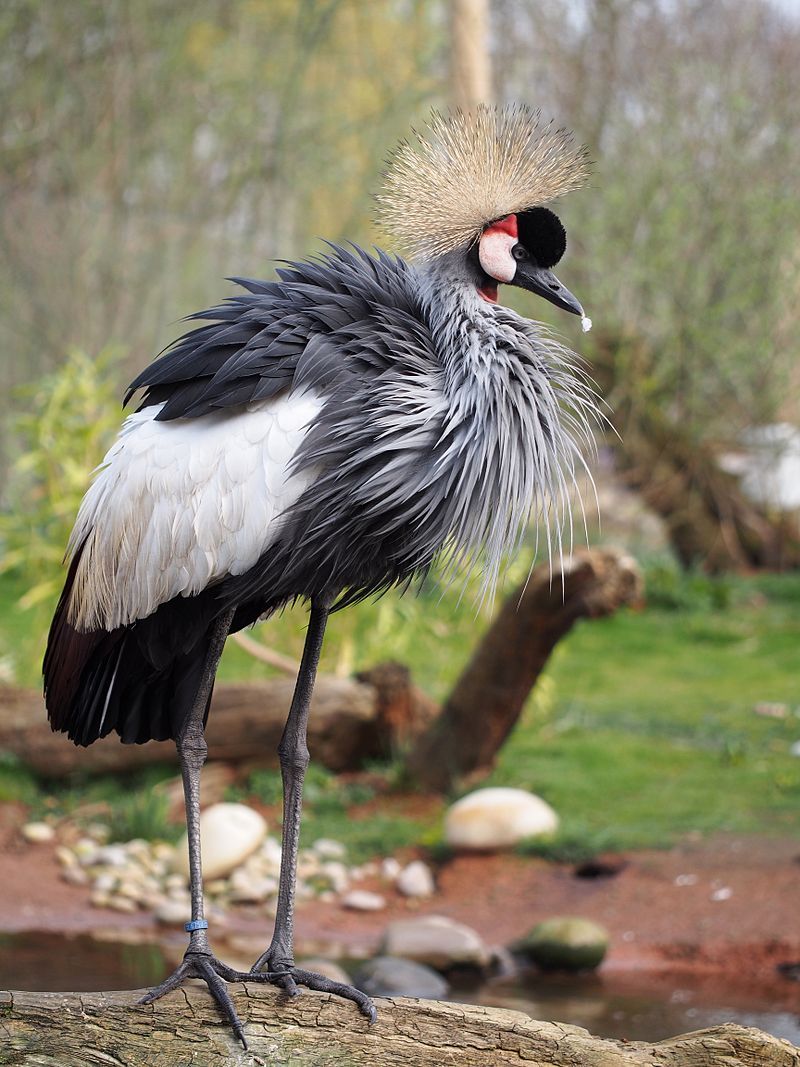
The Grey Crowned Crane is a unique species of bird that belongs to the Gruidae family.
It is also commonly referred to as the African Crowned Crane, Golden Crested Crane, Golden Crowned Crane, East African Crane, East African Crowned Crane, African Crane, Eastern Crowned Crane, Kavirondo Crane, South African Crane, and Crested Crane.
This bird is native to Africa and some parts of Asia, and is known for its distinctive grey crown and white body. This bird is a large species, with a long neck and long legs, and a wingspan of up to 2.4 meters.
Its body is mostly white with black wingtips, and it has a distinctive grey crown on its head.
The Grey Crowned Crane also has a red patch of skin on its face, near its eyes, and a yellow patch of feathers on its throat. In the wild, the Grey Crowned Crane lives in wetland habitats such as marshes, swamps, floodplains, and grasslands.
It feeds on insects, reptiles, amphibians, small mammals, and grain, and it can also be seen around human settlements, feeding on grain left behind by farmers. The Grey Crowned Crane is a social bird and is usually seen in pairs or small groups.
It is also known for its elaborate courtship displays, which involve loud trumpeting and dancing. The Grey Crowned Crane is an important symbol of luck and peace in African cultures, and it is also listed as a vulnerable species due to habitat loss and hunting.
| Kingdom | Animalia |
| Phylum | Chordata |
| Class | Aves |
| Order | Gruiformes |
| Family | Gruidae |
| Genus | Balearica |
| Species | B. regulorum |
2. Hamerkop
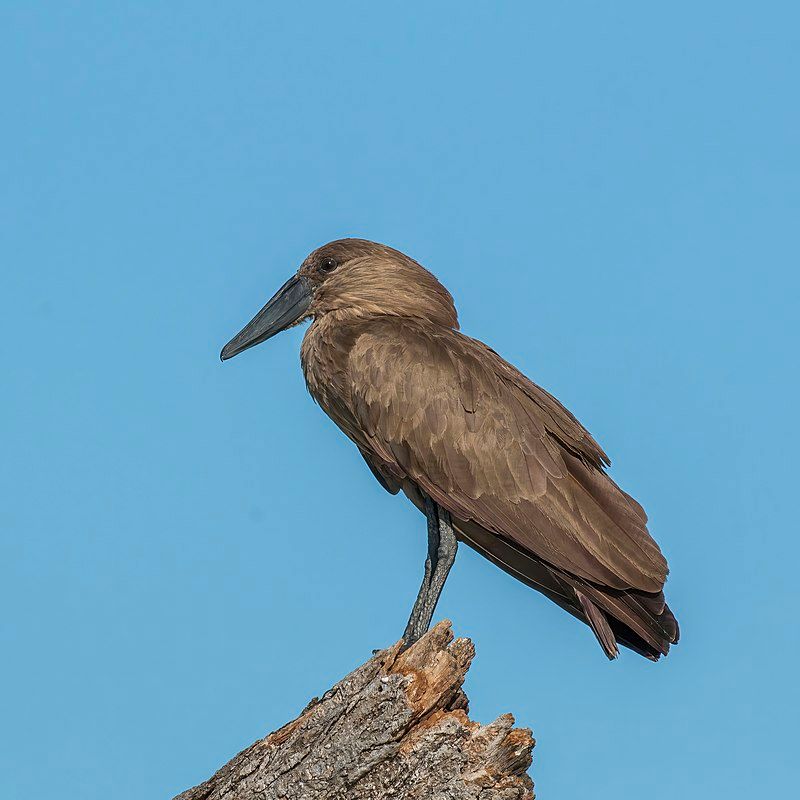
The hamerkop is a unique bird species belonging to the Pelecaniformes order, which is comprised of pelicans, herons, ibises, and storks. It is the only living species in the genus Scopus and the family Scopidae and is a medium-sized wading bird.
For a long time, the species was thought to belong to the Ciconiiformes order, but recent research has suggested that its closest relatives are actually the pelicans and the shoebill. This suggests that the hamerkop should be placed within the Pelecaniformes order.
The hamerkop is a distinctive bird, with a large crest and a long, curved bill which it uses to catch its prey. Its habitat consists of wetlands, rivers, and lakes, and it feeds mainly on fish, frogs, and insects.
Its distinctive appearance and behavior make it a unique species, and its placement within the Pelecaniformes order highlights its close relationship with the pelicans and the shoebill.
| Kingdom | Animalia |
| Phylum | Chordata |
| Class | Aves |
| Order | Pelecaniformes |
| Family | Scopidae |
| Genus | Scopus |
| Species | S. umbretta |
3. African Finfoot
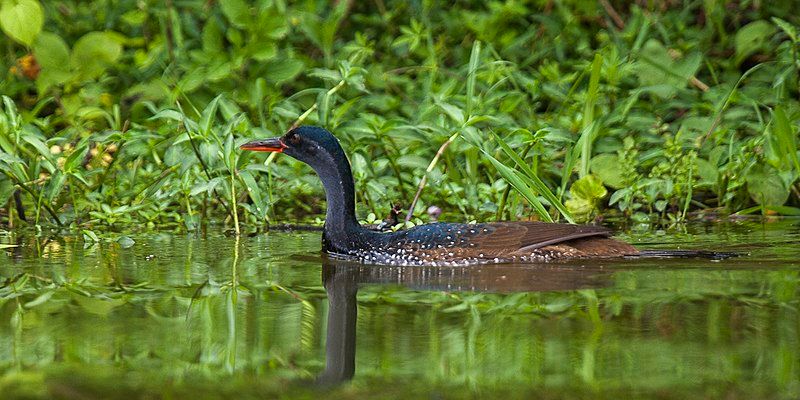
The African finfoot is a species of aquatic bird that belongs to the family Heliornithidae. This species of bird is found in the rivers and lakes of western, central, and southern Africa.
It has a wide range and is found in a variety of habitats, such as lakes, rivers, swamps, and floodplains, as well as in areas that are heavily vegetated. The African finfoot is a medium-sized bird that is characterized by its long, slender neck and body, and its distinctive black-and-white plumage.
It also has bright red eyes and a bright yellow bill. Its wings are relatively short and its legs are powerful, allowing it to swim and dive well.
It is also able to perch on floating vegetation. The African finfoot is a relatively solitary species and is mostly active during the day. During the breeding season, it will form small groups and will often be found around the edges of lakes and rivers.
It feeds mainly on fish, crustaceans, mollusks, and insects, which it catches with its bill. It will also feed on the seeds and fruits of aquatic vegetation. The African finfoot is an important species for the conservation of the aquatic habitats in which it occurs.
It is also often hunted for food in some parts of its range. Unfortunately, its population is decreasing due to habitat destruction and degradation, as well as hunting and other human activities. As a result, the species is listed as Near Threatened on the IUCN Red List.
| Kingdom | Animalia |
| Phylum | Chordata |
| Class | Aves |
| Order | Gruiformes |
| Family | Heliornithidae |
| Genus | Podica |
| Species | P. senegalensis |
4. Egyptian Goose
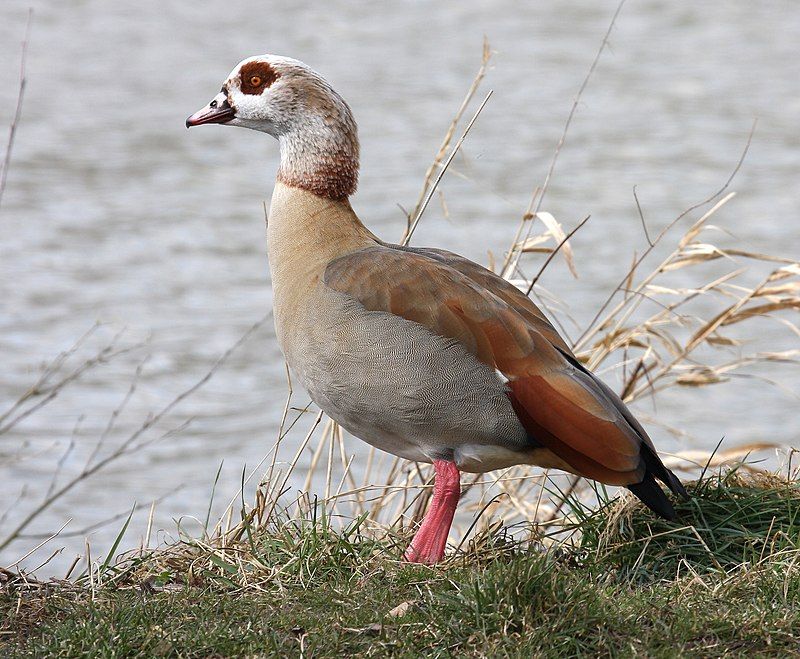
The Egyptian goose is a species of duck found in Africa. It is a member of the Anatidae family, which includes ducks, geese, and swans. The species is known for its popularity among birders and is often kept as an ornamental bird.
As a result of its popularity, it has been introduced to regions outside of its native range, such as Europe, the United States, and other locations. The introduction of this species has had mixed results, as it has caused some problems with native wildlife in some areas.
Some populations of the species have become invasive, causing damage to the local ecosystem. In other areas, the species has been welcomed as a new addition to the local avian community.
| Kingdom | Animalia |
| Phylum | Chordata |
| Class | Aves |
| Order | Anseriformes |
| Family | Anatidae |
| Genus | Alopochen |
| Species | A. aegyptiaca |
5. Yellow-necked Spurfowl
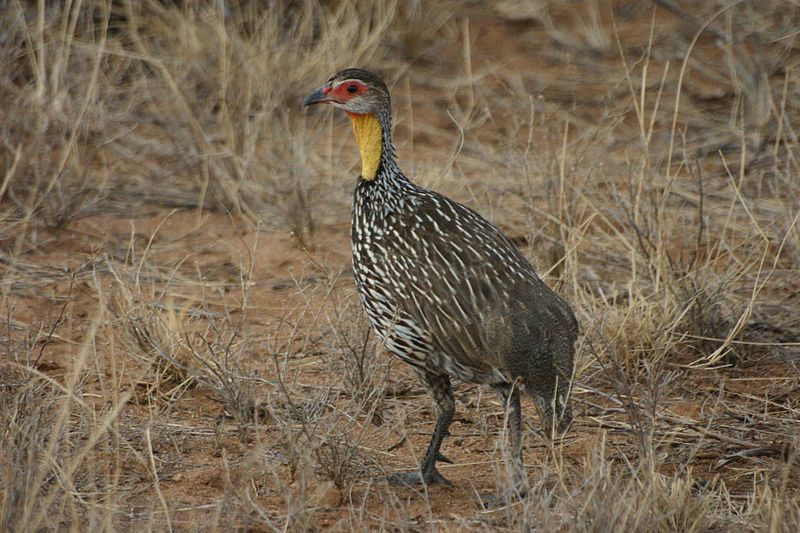
The yellow-necked spurfowl, also known as a yellow-necked francolin, is a species of bird found in many African countries, including Djibouti, Eritrea, Ethiopia, Kenya, Somalia, Sudan, Tanzania, and Uganda.
This species is distinguished by the yellow patch found on its neck, which is the reason for its name. The yellow-necked spurfowl is a member of the family Phasianidae, which is a large group of landfowl that includes partridges, pheasants, and other game birds.
This species is found in areas with dense shrubland and forests, as well as open grasslands. The yellow-necked spurfowl is mainly a terrestrial bird, spending most of its time on the ground foraging for food.
Its diet consists predominantly of seeds, insects, and other small invertebrates. The yellow-necked spurfowl is an important species in its native range, providing an important source of food for local people. It is also a popular game bird and is hunted for food and sport.
This species is considered to be of least concern by the International Union for Conservation of Nature (IUCN), as its population is widespread and stable.
| Kingdom | Animalia |
| Phylum | Chordata |
| Class | Aves |
| Order | Galliformes |
| Family | Phasianidae |
| Genus | Pternistis |
| Species | P. leucoscepus |
6. Hartlaub’s Bustard
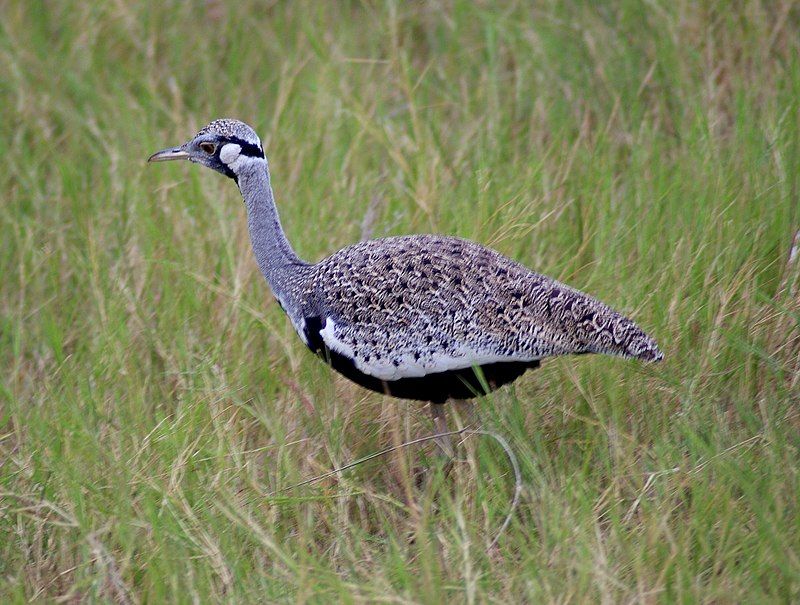
Hartlaub’s bustard is a species of bird belonging to the Otididae family, which is found in several countries in the Eastern Africa region. It prefers open grasslands where grass can grow up to 1800 meters in height.
These countries include Ethiopia, Kenya, Somalia, Sudan, Tanzania, and Uganda. The species is named after the German physician and ornithologist Gustav Hartlaub, who was one of the first to study the species and write about it in detail.
Hartlaub’s research provided valuable insight into the bird’s behavior and habitat, as well as its physical characteristics. His contribution to the field of ornithology earned him the honor of having a species of bird named after him.
| Kingdom | Animalia |
| Phylum | Chordata |
| Class | Aves |
| Order | Otidiformes |
| Family | Otididae |
| Genus | Lissotis |
| Species | L. hartlaubii |
7. Hooded Vulture
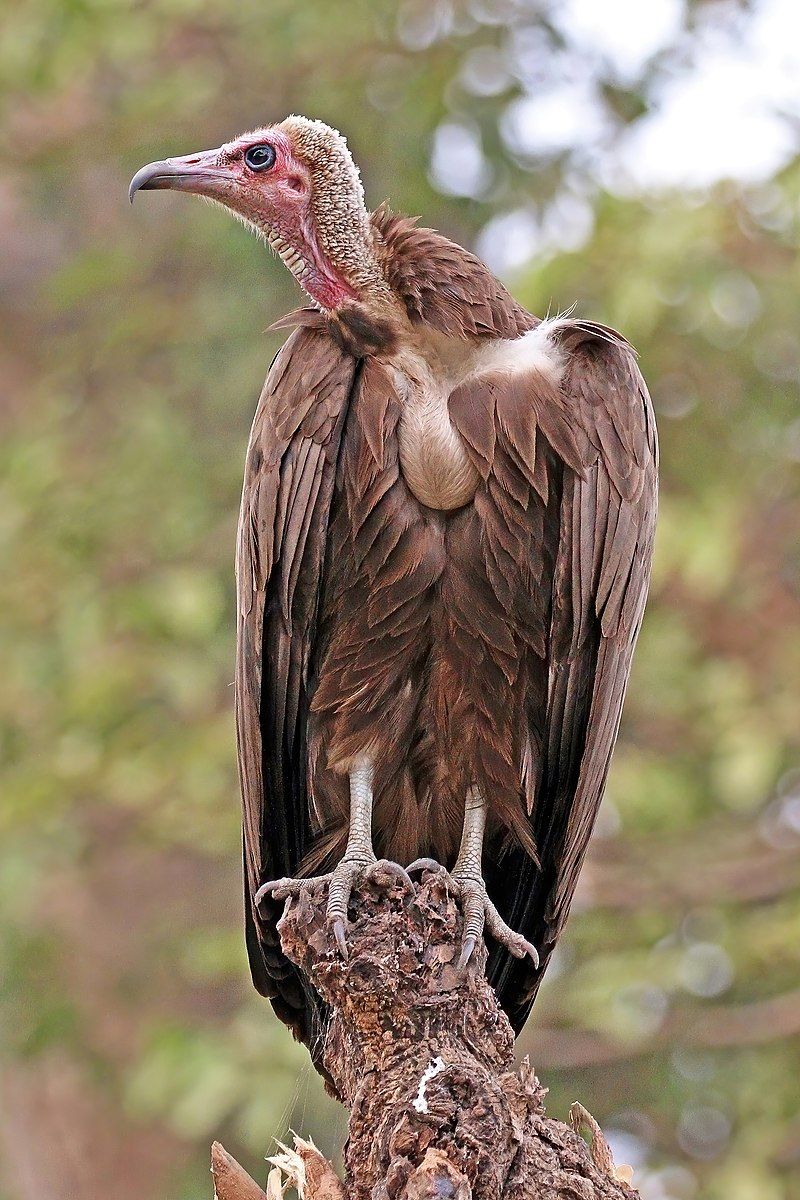
The hooded vulture is a species of bird belonging to the Old World vulture family, which is found in the order Accipitriformes. This order also includes birds such as eagles, kites, buzzards and hawks.
The hooded vulture is the only species in the genus Necrosyrtes, which is closely related to the larger Gyps genus. Both of these genera are part of the Aegypiinae subfamily of Old World vultures.
The hooded vulture is an interesting species, with a unique characteristic that sets it apart from other birds in the order Accipitriformes. It has a distinctive hood-like structure on its head, which is used to protect its eyes from the sun while it is soaring in the air.
It also has a strong, hooked beak to tear apart carrion. This species is found throughout Africa and the Middle East, and it feeds mainly on carcasses. The hooded vulture is an important species, as it helps to keep the environment clean.
As a scavenger, it helps to recycle nutrients from dead animals and plants, which helps to keep the environment healthy. It is also an important part of the food chain, providing food to other predators such as lions and hyenas.
The hooded vulture is a unique species, and its place in the order Accipitriformes is an important one. Its unique characteristics and its important ecological role make it an important part of the ecosystem.
| Kingdom | Animalia |
| Phylum | Chordata |
| Class | Aves |
| Order | Accipitriformes |
| Family | Accipitridae |
| Genus | Necrosyrtes |
| Species | N. monachus |
8. Buff-crested Bustard
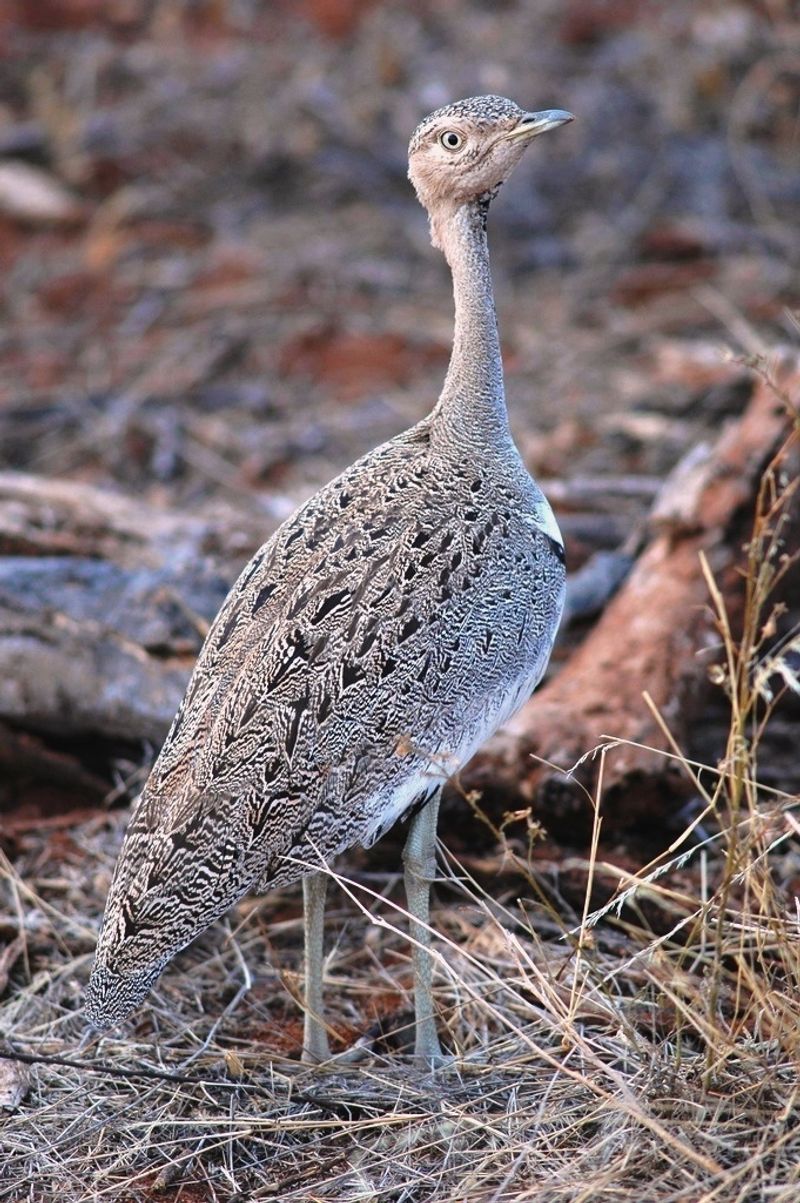
The buff-crested bustard is a species of bird found in East Africa. It is medium-sized, belonging to the family Otididae, and is considered to be a stable population.
As a result, the species is classified as being of least concern in terms of conservation. This species is native to East Africa and is fairly widespread across the region. It is a medium-sized bird, with males being larger than females.
The buff-crested bustard has a distinctive crest of feathers on its head, with the males having a white head, neck, and back, brown wings, and a black tail.
The female is generally a mottled brown with a white throat. The buff-crested bustard has a diet that consists mainly of insects and small vertebrates, such as rodents, lizards, and snakes. It is also known to eat fruit and seeds.
It is a ground-dwelling bird, typically found in grasslands and savannahs. Despite some local declines, the overall population of the buff-crested bustard is considered to be stable. As a result, the species is of least concern in terms of conservation.
The bird is not considered to be threatened or endangered and is not subject to any specific conservation efforts.
| Kingdom | Animalia |
| Phylum | Chordata |
| Class | Aves |
| Order | Otidiformes |
| Family | Otididae |
| Genus | Lophotis |
| Species | L. gindiana |
9. Common Ostrich
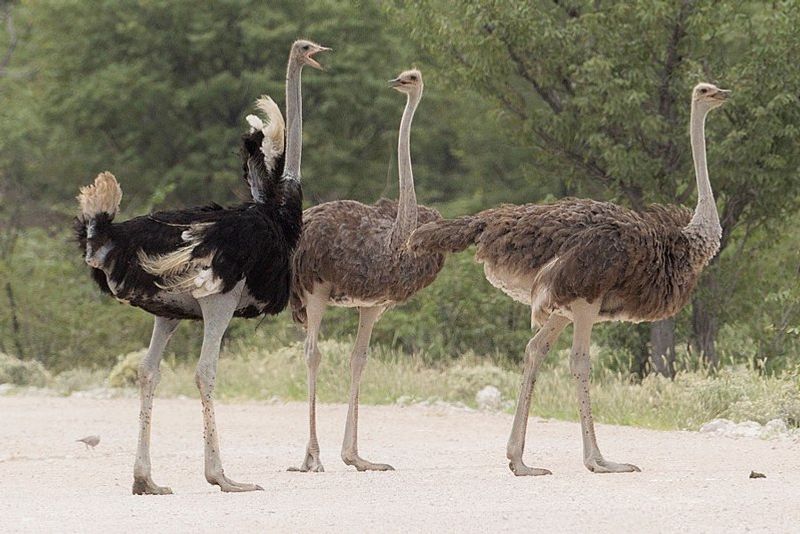
The common ostrich is an impressive species of flightless bird that is found in various parts of Africa. This bird is part of the ratite order of birds and is the only living member of the genus Struthio.
Ostriches are the largest living birds and can grow up to nine feet tall and weigh over 300 pounds. They are well-known for their powerful legs, which allow them to run at speeds up to 40 miles per hour. Their long, feathered necks and large eyes make them look even taller.
Ostriches are also unique in that they have two toes on each foot, unlike most birds which have three or four. They have a powerful beak and can feed on a wide variety of grasses, plants, seeds, and insects.
Although they cannot fly, ostriches are powerful swimmers and can even use their wings to help them paddle across lakes. They are also very social birds, often living in large flocks of up to a hundred individuals.
The common ostrich is a remarkable species that is an important part of the African savanna ecosystem.
| Kingdom | Animalia |
| Phylum | Chordata |
| Class | Aves |
| Order | Struthioniformes |
| Family | Struthionidae |
| Genus | Struthio |
| Species | S. camelus |
10. Martial Eagle
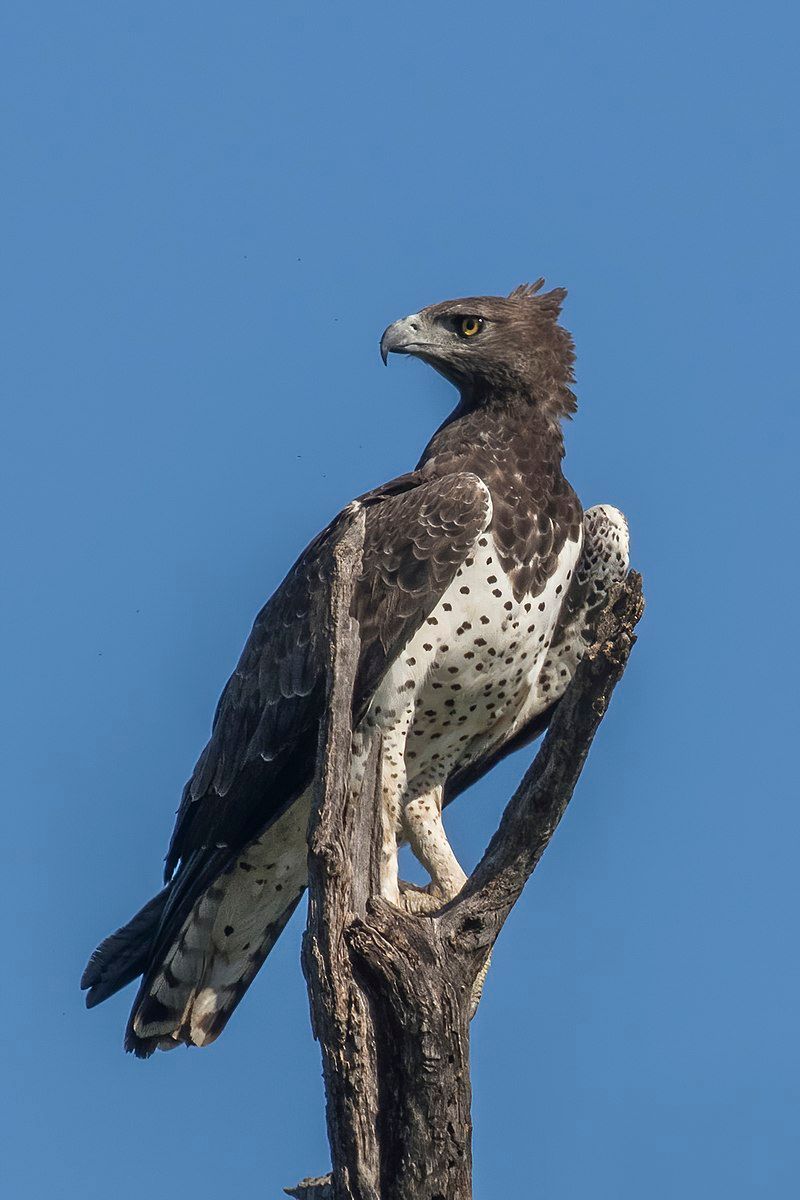
The martial eagle is a large species of eagle found in sub-Saharan Africa. It is the only bird of its kind, belonging to the genus Polemaetus.
This genus is part of the booted eagle subfamily, which is characterized by feathers that cover its tarsus, the lower part of its legs. The martial eagle is an impressive bird, with a wingspan of up to 2.3 meters (7.5 feet) and a body length of up to 70 cm (28 inches).
Its wings are broad and powerful, allowing it to soar through the air with great agility.
It has a distinctive white and black pattern on its wings and tail feathers, and its plumage is generally dark brown. The martial eagle is an apex predator, meaning it is top of the food chain in its environment.
Its diet consists mainly of small mammals, such as rodents, hares, and even small antelopes. It also feeds on reptiles, amphibians, and birds.
Its powerful talons allow it to snatch its prey from the air, as well as from the ground. The martial eagle is an important part of the African ecosystem. It helps to control the population of small mammals, which can have a detrimental effect on local vegetation.
It is also an important source of food for other predators, such as jackals and hyenas. Unfortunately, the martial eagle is threatened by habitat loss and human activities, such as hunting and poisoning. It is currently listed as an endangered species on the IUCN Red List.
| Kingdom | Animalia |
| Phylum | Chordata |
| Class | Aves |
| Order | Accipitriformes |
| Family | Accipitridae |
| Genus | Polemaetus |
| Species | P. bellicosus |
11. Ostrich
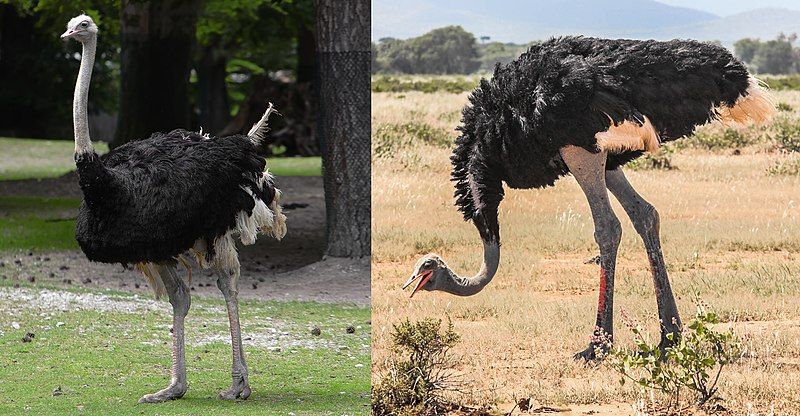
Ostriches are a unique species of birds that have some remarkable characteristics. They are the largest and heaviest living birds and lay the largest eggs of any land animal.
An amazing fact about ostriches is that they can run at speeds of up to 70 km/h, making them the fastest birds on land. They are farmed in many countries around the world, particularly in the Philippines and Namibia.
These two countries have significant industries related to ostrich farming which contribute to their economies. Ostrich farming provides people with a source of income, as well as offering a valuable source of food.
In addition, ostriches are used in a variety of ways, such as in the production of leather goods, feathers, and eggs. They can also be used for their meat, which is said to be very tender and tasty.
Ostrich farming is an important part of the economy in many countries and is an important source of food for many people.
| Kingdom | Animalia |
| Phylum | Chordata |
| Class | Aves |
| Order | Struthioniformes |
| Family | Struthionidae |
| Genus | Struthio |
12. Marabou Stork
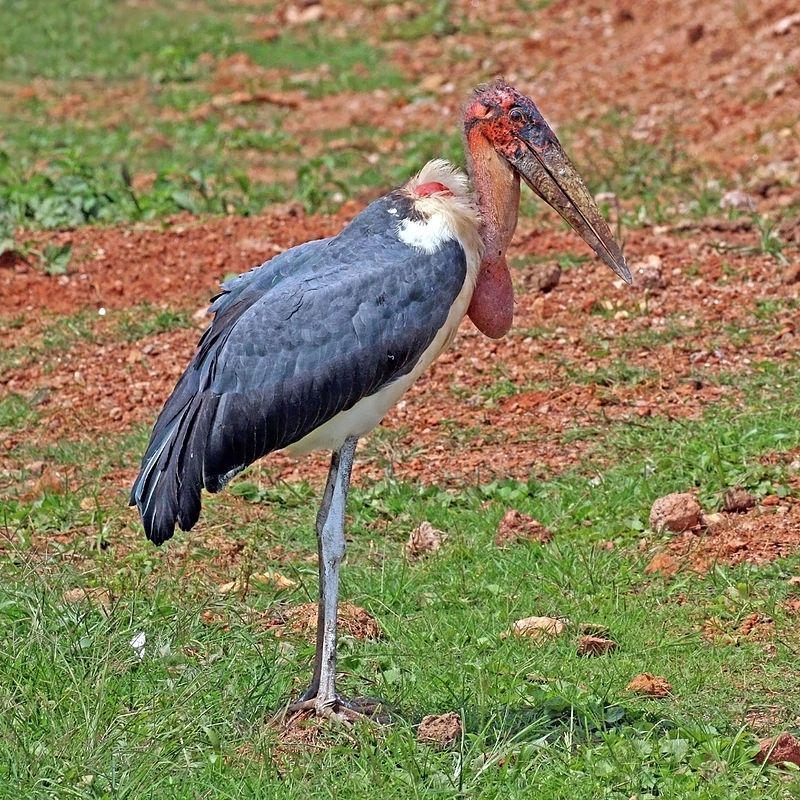
The marabou stork is a large wading bird found in sub-Saharan Africa. This species belongs to the stork family Ciconiidae and is known for its ability to adjust to different types of habitats.
The marabou stork typically resides in both wet and arid climates and is often seen in areas near human habitation. This bird is particularly attracted to landfill sites, where it is able to scavenge for food.
The marabou stork is a large bird, with a wingspan that can reach up to 2.7 meters. Its plumage is predominantly white, with black feathers on its wings and tail.
The marabou stork is an important species to its ecosystem, as it helps to keep the environment clean by feeding on carrion. It is also a popular bird for birdwatchers, as its large size and striking color palette make it an impressive sight.
| Kingdom | Animalia |
| Phylum | Chordata |
| Class | Aves |
| Order | Ciconiiformes |
| Family | Ciconiidae |
| Genus | Leptoptilos |
| Species | L. crumenifer |
13. Lesser Flamingo
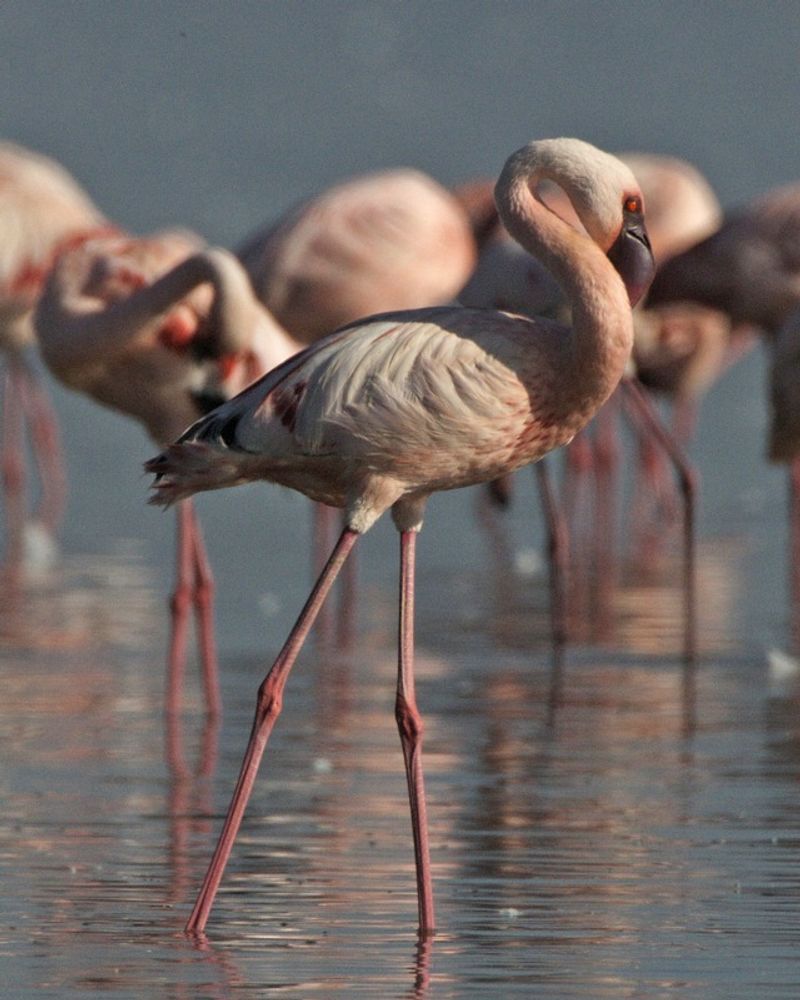
The lesser flamingo is a species of flamingo found in sub-Saharan Africa and western India. It is the most abundant species of flamingo and is distinguished by its pink-red coloration. Its diet consists primarily of blue-green algae, which gives it its distinct color.
Lesser flamingos typically live in shallow lakes, salt pans, and mudflats, as well as lagoons and estuaries. They are social birds and usually form large colonies.
Although the lesser flamingo is mainly found in sub-Saharan Africa and western India, there have been reports of birds further north. These sightings are usually considered to be vagrants, meaning the birds have strayed from their normal range.
| Kingdom | Animalia |
| Phylum | Chordata |
| Class | Aves |
| Order | Phoenicopteriformes |
| Family | Phoenicopteridae |
| Genus | Phoeniconaias |
| Species | P. minor |
14. White-bellied Bustard
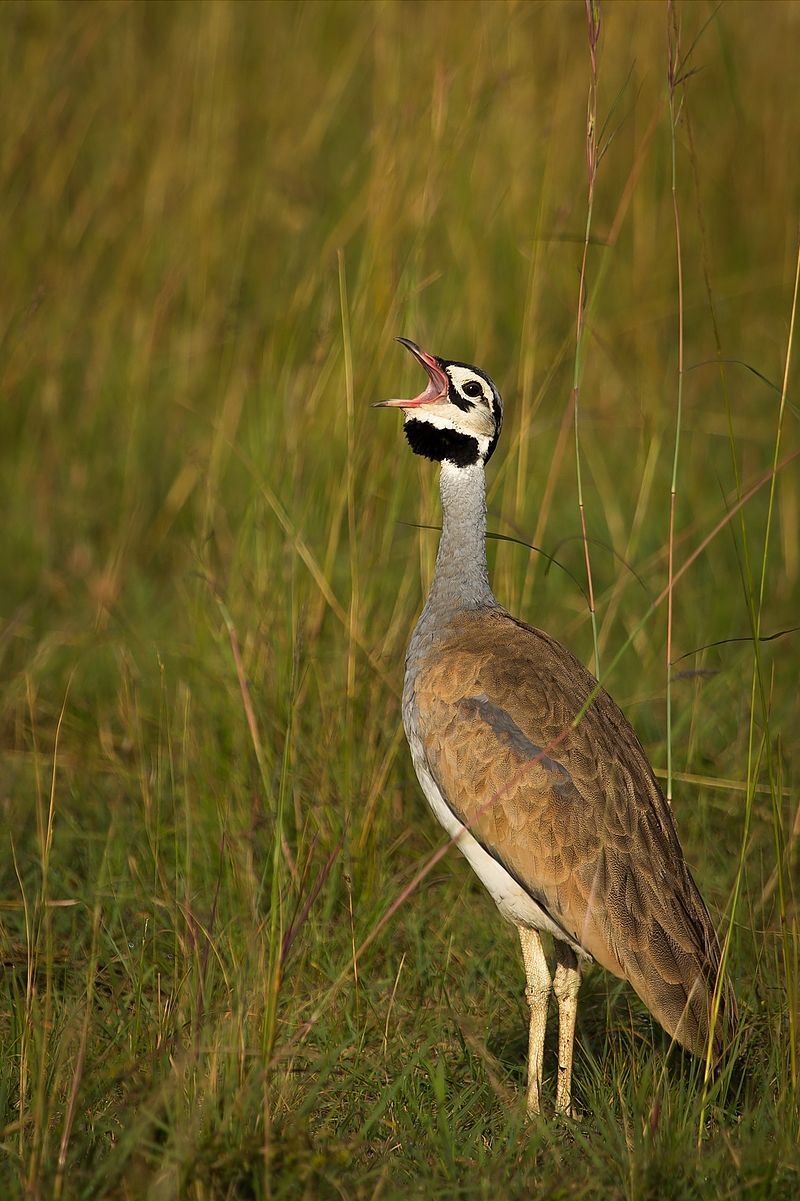
The white-bellied bustard, also known as the white-bellied korhaan, is a species of large bird that is native to sub-Saharan Africa. It is a member of the bustard family, which is one of the heaviest-flying birds in the world.
The white-bellied bustard is characterized by its white or grayish-white underparts, and its long neck and long, pointed tail.
Its head is generally dark brown or black, and its back is dark brown with a black-and-white pattern. The white-bellied bustard is a ground-dwelling bird and is usually found in open grassland or open woodland habitats.
It feeds mainly on insects, but it will also eat plants and small animals. It is diurnal, meaning that it is active during the day.
The white-bellied bustard is a migratory species, and it can be seen in different parts of Africa during different times of the year. The white-bellied bustard is a threatened species due to habitat loss and overhunting.
It is listed as Vulnerable on the IUCN Red List and is protected by law in many parts of Africa. Conservation efforts are underway to help protect this species and to ensure that its population remains healthy and stable.
| Kingdom | Animalia |
| Phylum | Chordata |
| Class | Aves |
| Order | Otidiformes |
| Family | Otididae |
| Genus | Eupodotis |
| Species | E. senegalensis |
15. Abyssinian Nightjar
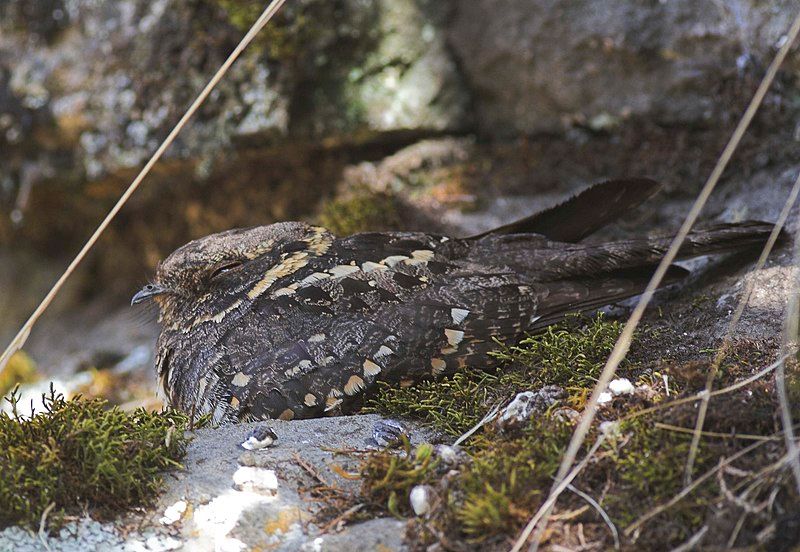
The montane nightjar, also known as the mountain nightjar or Abyssinian nightjar, is a species of nightjar from the family Caprimulgidae. It is a bird that is native to Central and Eastern Africa, residing in upland regions of the continent.
This nocturnal species is locally common in its natural habitat, which is ideal for its lifestyle. The montane nightjar has a short, round body and long wings that allow it to soar easily in the air.
It is a small bird, with a length of around 18 cm, and is usually colored a grayish-brown. It has white spots on its wings and a white-tipped tail. This species utilizes its large eyes and camouflage colors to remain unseen during the day and hunt for insects at night.
During the day, the montane nightjar remains motionless in order to conserve energy and avoid detection. With its unique combination of adaptations, it is well-adapted to life in the upland regions of Central and Eastern Africa, where it is a locally common species.
| Kingdom | Animalia |
| Phylum | Chordata |
| Class | Aves |
| Clade | Strisores |
| Order | Caprimulgiformes |
| Family | Caprimulgidae |
| Genus | Caprimulgus |
| Species | C. poliocephalus |
16. Black-faced Sandgrouse
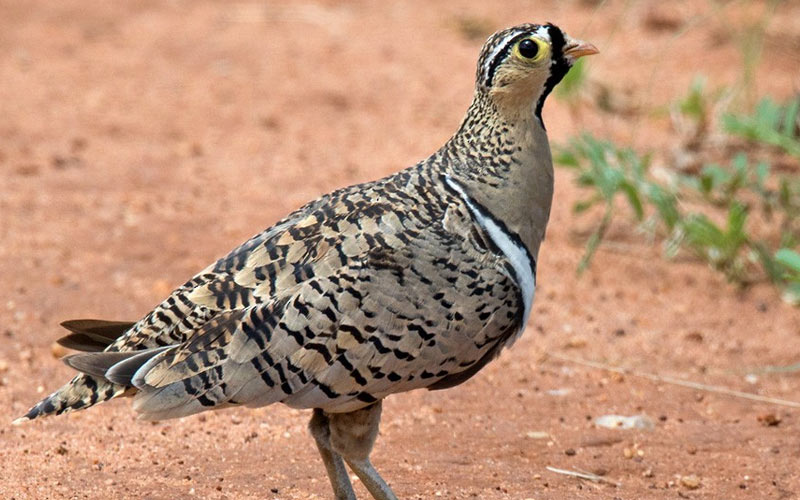
Source: ebird.org
The black-faced sandgrouse is a type of bird native to East Africa. It belongs to the Pteroclidae family, which also includes other species of sandgrouse. It is found in Ethiopia, Kenya, Somalia, Tanzania, and Uganda.
It is a medium-sized bird with a greyish-brown back and black face. Its wings are long and pointed, and its tail is short. It has a short neck and a thin pointed bill. The black-faced sandgrouse inhabits open grasslands and arid scrublands, where it feeds on seeds and insects.
It nests on the ground in a shallow depression lined with feathers and usually lays a clutch of two to four eggs. The female incubates the eggs and both parents care for the chicks.
The young fledge after about three weeks. The black-faced sandgrouse is threatened by habitat destruction and hunting. It is also vulnerable to predation by cats, jackals, and eagles.
Conservation efforts are being undertaken to protect the species, including habitat restoration and protection, and restrictions on hunting.
| Kingdom | Animalia |
| Phylum | Chordata |
| Class | Aves |
| Order | Pterocliformes |
| Family | Pteroclidae |
| Genus | Pterocles |
| Species | P. decoratus |
17. Greater Painted-snipe
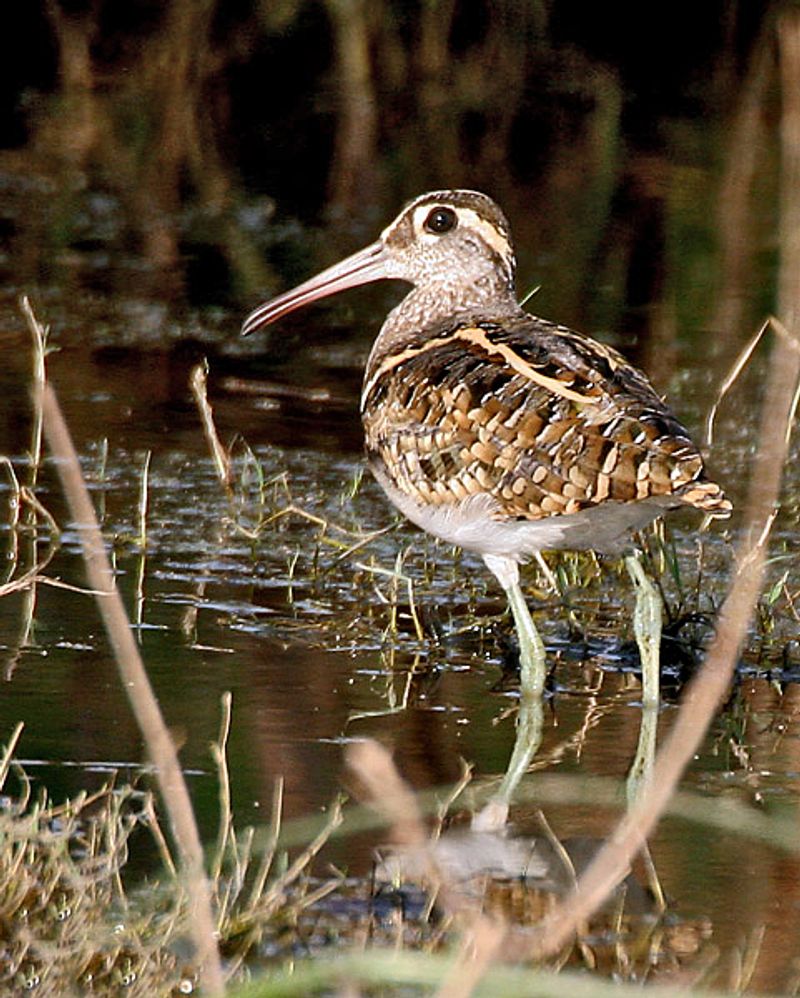
The greater painted-snipe is a species of wader that belongs to the family Rostratulidae. This species of wader can be found in various marshes in Africa, South Asia, and Southeast Asia.
The greater painted-snipe is an unmistakable bird with its black and white plumage on the head and neck, and its chestnut body. It has long red legs and a long, thin beak that can be used to probe for food in muddy marshes.
The greater painted snipe has a predominantly solitary lifestyle and is usually found alone or in pairs. It feeds mainly on terrestrial and aquatic insects, as well as other small invertebrates. During the breeding season, these birds construct a simple nest in the marsh.
The greater painted-snipe is an important species in the wetland ecosystems of its range, as it helps to maintain healthy populations of insects and other invertebrates.
Unfortunately, this species is threatened by habitat destruction and hunting in some parts of its range, and its numbers have been declining in recent years.
| Kingdom | Animalia |
| Phylum | Chordata |
| Class | Aves |
| Order | Charadriiformes |
| Family | Rostratulidae |
| Genus | Rostratula |
| Species | R. benghalensis |
18. Harlequin Quail
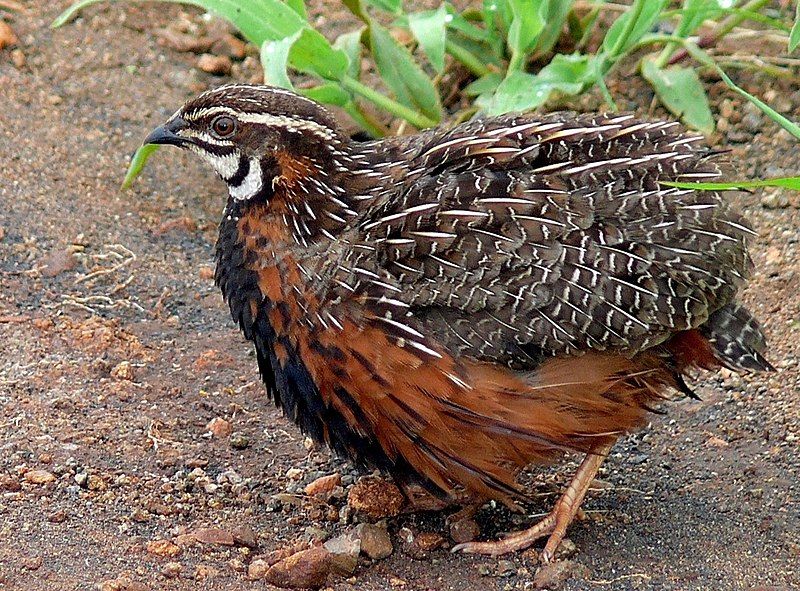
The harlequin quail is a species of bird in the family Phasianidae, which includes pheasants, partridges, and grouse. This species is found in sub-Saharan Africa and the Arabian Peninsula.
It is distinct from other birds in the family due to its small size, its distinctive black-and-white pattern, and its reddish-brown crest. The species is named after the collector, Adulphe Delegorgue.
Delegorgue was a French naturalist who collected many specimens of the harlequin quail during his travels in Africa and the Arabian Peninsula. He was the first to give a scientific description of the species, and it was later named in his honor.
The harlequin quail is a ground-dwelling bird and it prefers to live in grassy habitats. It feeds mainly on seeds, but also eats insects, small fruits, and other plant material. It is a non-migratory species and typically forms small flocks of up to five birds.
The species is generally not considered threatened, but its population is believed to be declining due to habitat loss and hunting pressure.
| Kingdom | Animalia |
| Phylum | Chordata |
| Class | Aves |
| Order | Galliformes |
| Family | Phasianidae |
| Genus | Coturnix |
| Species | C. delegorguei |
19. Somali Ostrich
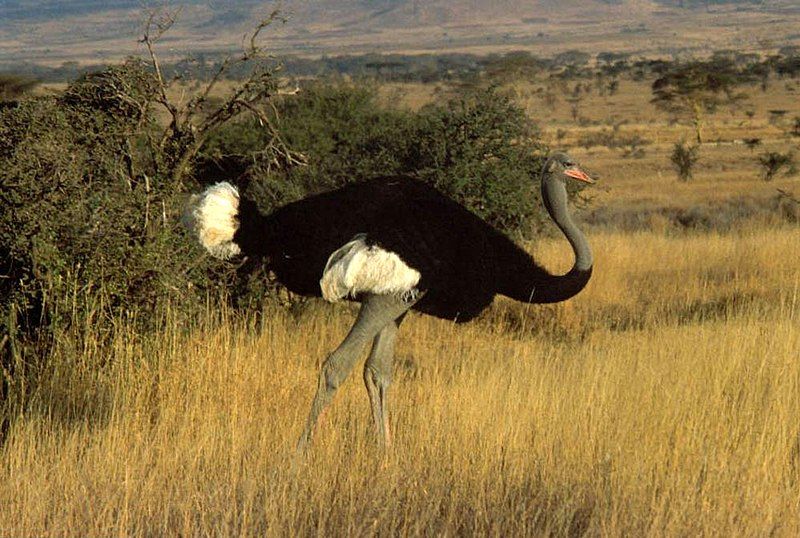
The Somali ostrich, also known as the blue-necked ostrich, is a large, flightless bird native to the Horn of Africa. It is one of the two living species of ostrich, the other being the common ostrich.
Until recently, the Somali ostrich was thought to be a subspecies of the common ostrich, but a scientific study published in 2014 determined that it is its own species. The Somali ostrich can reach a height of up to 8 feet and can weigh up to 280 pounds.
It has a distinctive blue-gray neck and legs, with a white body and black wings. It is a herbivore, feeding mainly on leaves, buds, and twigs.
It can also live up to 40 years in the wild. Despite its size and strength, the Somali ostrich is still threatened by habitat destruction, illegal hunting, and other human activities.
There is estimated to be only a few thousand Somali ostriches left in the wild, and they are classified as a vulnerable species by the International Union for Conservation of Nature. Conservation efforts are needed to protect this species and ensure its survival.
| Kingdom | Animalia |
| Phylum | Chordata |
| Class | Aves |
| Order | Struthioniformes |
| Family | Struthionidae |
| Genus | Struthio |
| Species | S. molybdophanes |
20. White-browed Coucal
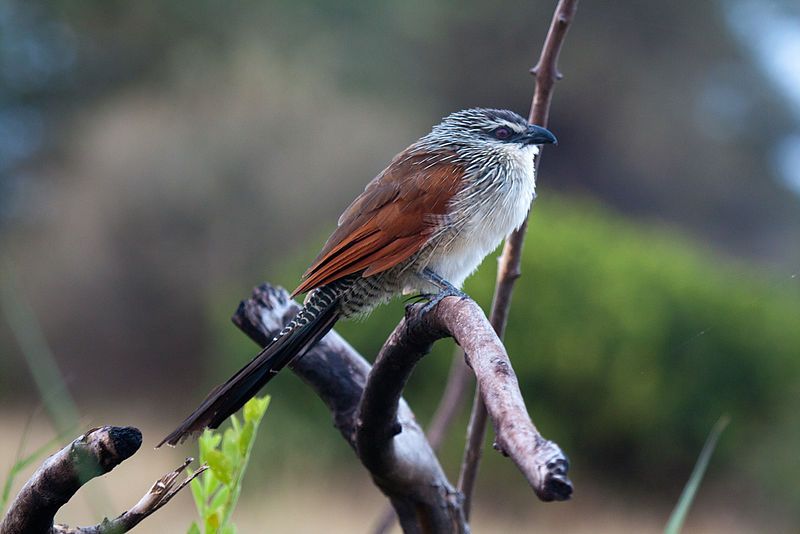
The white-browed coucal, also known as the lark-heeled cuckoo, is a species of bird belonging to the family Cuculidae. It is native to sub-Saharan Africa and is typically found in areas with thick vegetation, such as tall grass, scrub, and coastal regions.
In some cases, it is considered to be a subspecies of Burchell’s coucal. This species of cuckoo is known for its distinctive white brows and for its unique call, which is a loud and far-reaching cuckoo sound.
Its diet mainly consists of insects, such as caterpillars and grasshoppers, as well as small reptiles and amphibians. It is a solitary species but can form pairs when breeding.
The female builds the nest and incubates the eggs, while the male defends the territory and provides food for the young.
The white-browed coucal is an important species in its habitat, as it plays an important role in controlling the population of many insects and other small animals. Its population is considered to be stable, and it is not currently threatened with extinction.
| Kingdom | Animalia |
| Phylum | Chordata |
| Class | Aves |
| Order | Cuculiformes |
| Family | Cuculidae |
| Genus | Centropus |
| Species | C. superciliosus |
21. Crowned Eagle
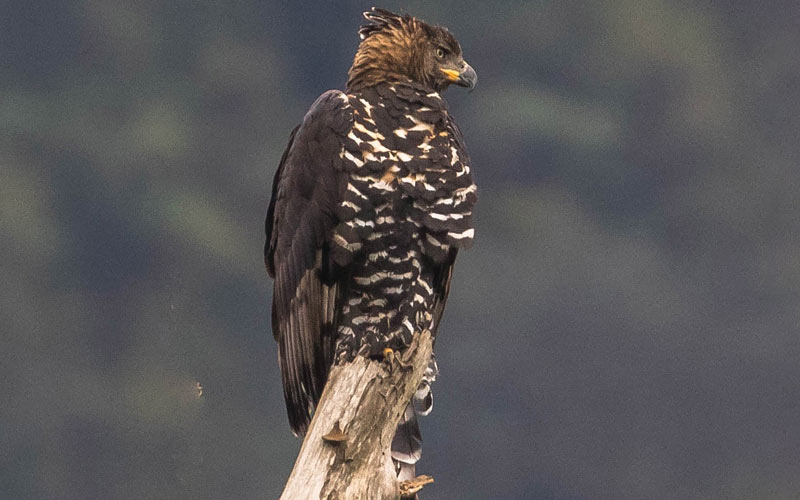
Source: ebird.org
The crowned eagle, also known as the African crowned eagle or the crowned hawk-eagle, is a large bird of prey found mainly in sub-Saharan Africa, a region of the African continent south of the Sahara desert. In Southern Africa, the crowned eagle is only found in eastern areas.
This bird of prey has a preference for riparian woodlands and different kinds of forests. Riparian woodlands are wooded areas around rivers and streams, while forests can range from tropical rainforests to savanna woodlands.
The crowned eagle is an impressive bird, with a wingspan that can reach up to 6.5 feet. It has a distinctive black and white plumage, with a black head and neck and white streaks on its back, wings, and tail. Its distinctive crown of feathers gives it its name.
This bird of prey hunts for a variety of prey, including small mammals, reptiles, and even other birds. It typically hunts from a perch, swooping down to capture its prey with its powerful talons.
The crowned eagle is an important part of the African ecosystem, helping to keep animal populations in balance. Unfortunately, this species is facing increasing threats due to habitat loss and illegal hunting.
Conservation efforts are needed to ensure the survival of this species.
| Kingdom | Animalia |
| Phylum | Chordata |
| Class | Aves |
| Order | Accipitriformes |
| Family | Accipitridae |
| Genus | Stephanoaetus |
| Species | S. coronatus |
22. Silvery-cheeked Hornbill
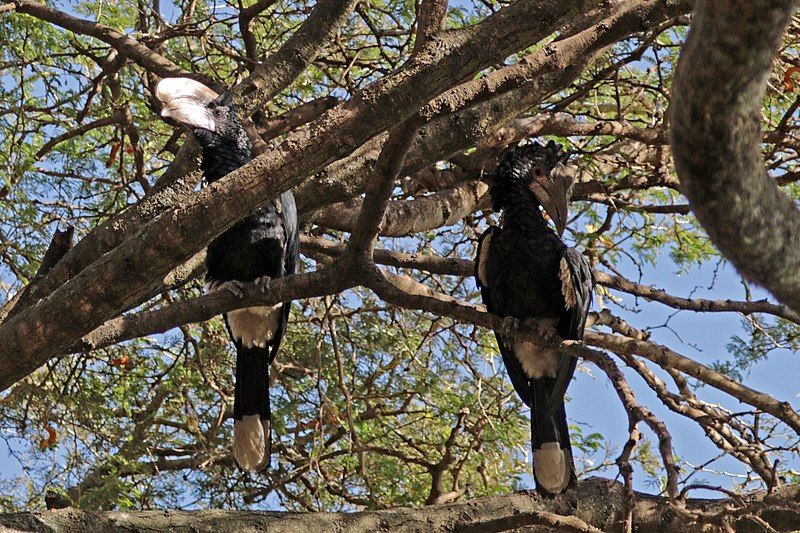
The silvery-cheeked hornbill is an impressive bird species native to the African continent. Its striking plumage and size make it stand out among other birds. It is a large bird, with a length of up to 1.3 meters, and is covered in silver feathers on its cheeks and head.
The silvery-cheeked hornbill is found in the tall and dense evergreen forests of East Africa, ranging from Ethiopia to South Africa. These majestic birds spend most of their time in the canopy of the forests, searching for food and nesting.
They mainly feed on fruit, insects, small reptiles, and small mammals. They build large nests in tree hollows, often using their beaks to dig them out. The silvery-cheeked hornbill is an important species to the ecology of the forests in which they live.
They are essential for pollination and help to keep the forests healthy and full of life.
| Kingdom | Animalia |
| Phylum | Chordata |
| Class | Aves |
| Order | Bucerotiformes |
| Family | Bucerotidae |
| Genus | Bycanistes |
| Species | B. brevis |
23. Black-winged Lapwing
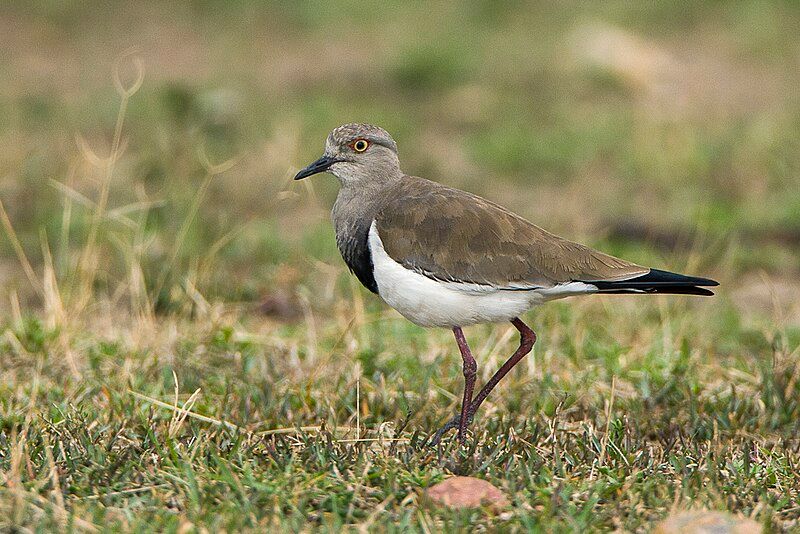
The black-winged lapwing, also known as the greater black-winged lapwing, is a species of bird found in East Africa. It is native to the Ethiopian highlands in the north and extends southwards to central Kenya.
Additionally, the species can also be found at middle to coastal elevations in eastern South Africa. This species of bird is a habitat specialist, and it prefers to live in short grass in well-watered temperate grasslands.
It is a resilient species, able to adjust to different climates and habitats. The black-winged lapwing is a relatively small species, although it is slightly larger than other species of lapwings. It has a white-colored head, a black back and wings, and yellow legs.
It feeds primarily on insects and other invertebrates, and can often be found in open areas where it can forage for food. The black-winged lapwing is an important species for its region and plays an important role in the local ecology.
| Kingdom | Animalia |
| Phylum | Chordata |
| Class | Aves |
| Order | Charadriiformes |
| Family | Charadriidae |
| Genus | Vanellus |
| Species | V. melanopterus |
24. Bearded Vulture
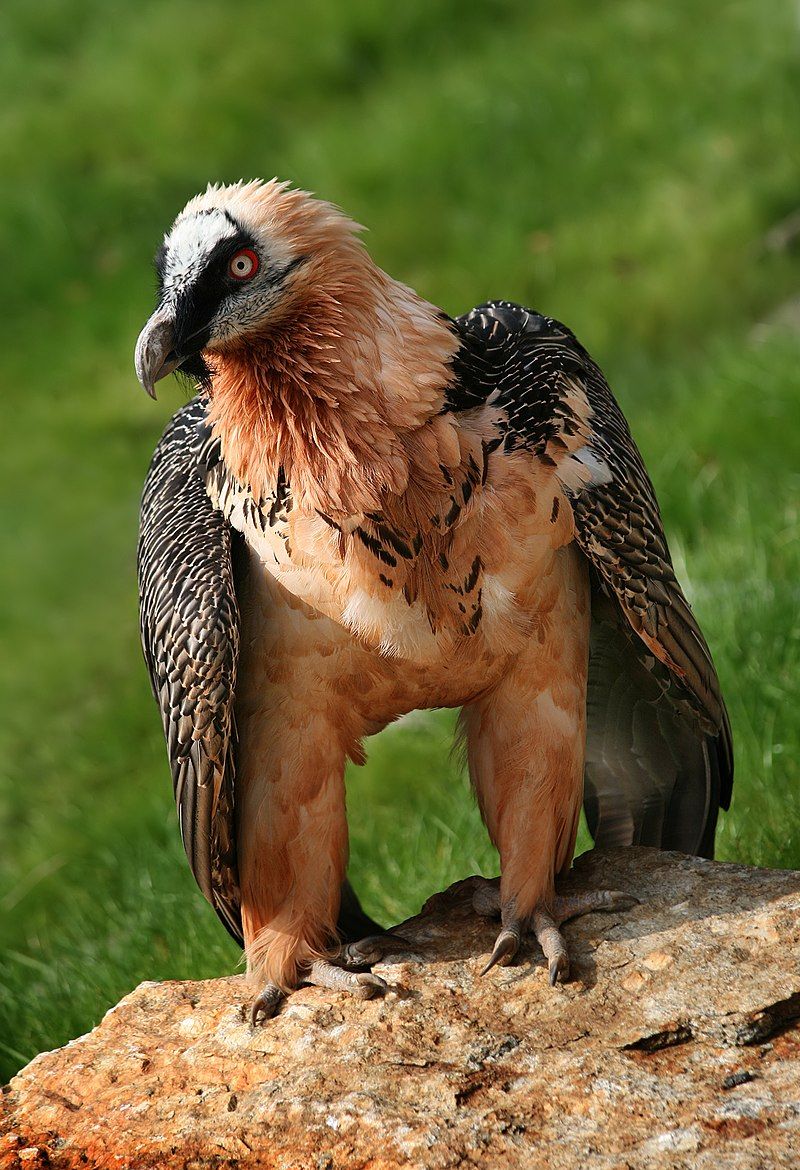
The Bearded Vulture is a large bird of prey that is part of the Accipitridae family. It has two other names: Lammergeier and Ossifrage. It is the only member of the genus Gypaetus, which is part of the Old World vulture group.
The closest living relative to the Bearded Vulture is the Egyptian Vulture, which belongs to the same minor lineage. This bird of prey is very large in size, with a wingspan of up to 9.8 feet.
Its feathers are usually black, with white patches on its wings and it has a distinctive red-brown beard on its face. It mainly feeds on bones and other carrion, often dropping the bones from a height onto rocks to break them open.
The Bearded Vulture can be found in a variety of habitats, including mountains, steppes, and deserts. The main areas where it is found are in southern Europe, the Middle East, Africa, India, and Tibet.
Populations of bearded vultures have been declining in recent years due to habitat loss, poisoning, and human interference. Conservation efforts are underway to protect this species and its habitats.
| Kingdom | Animalia |
| Phylum | Chordata |
| Class | Aves |
| Order | Accipitriformes |
| Family | Accipitridae |
| Genus | Gypaetus |
| Species | G. barbatus |
Conclusion
Birds in Laikipia provide an essential and beautiful addition to the area’s already vibrant ecology. They are an integral part of the local food web, providing sustenance to both humans and wildlife alike.
They also serve as indicators of environmental health, as their presence or absence can signal changes in the quality of the habitat.
Laikipia’s wide variety of bird species provides a unique opportunity to observe these important creatures in their natural habitats, and it is clear that the continued conservation of these birds is essential for the health of the entire ecosystem.